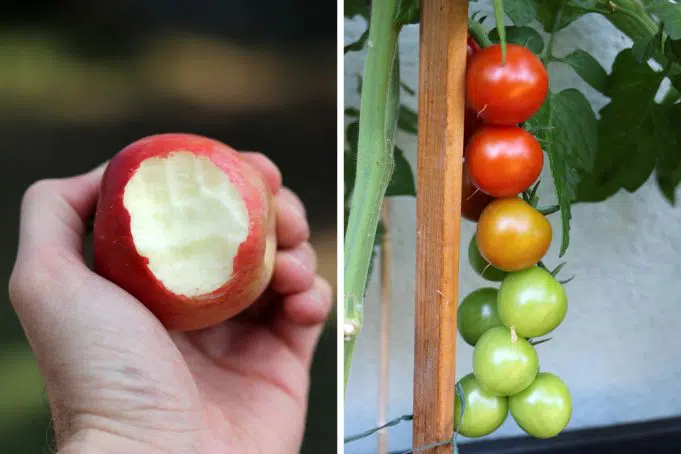Interesting question, so far most still go with. Immediately afterwards, even otherwise well occupied brains already formulate the question, why in heaven’s name do they need to know that?
Contents
Fruit
What fruit is, is not clearly defined. The term “fruit” summarizes as a so-called collective noun an indefinite number of similar things in a class.
The things are fruits, according to Wikipedia “for humans raw edible mostly watery fruits or parts thereof, which come from trees, shrubs and perennial perennials”. According to Duden “edible, mostly juicy fruits of certain trees and shrubs”, immediately with the remark that the saying “Thank you for fruits and tropical fruits”
Vegetables
“Vegetables” are just as vaguely defined, also a collective term. According to Wikipedia, “Edible parts of plants growing wild or cultivated, usually leaves, fruits, tubers, stems or roots of annual or biennial herbaceous plants, which are eaten raw, cooked or preserved.” According to Duden, “plants whose various parts are eaten in a raw or cooked state.”
Colloquial fruit and vegetables
Fruit, for most people, is sweet and juicy and to be eaten raw.
Vegetables can sometimes be eaten raw, mostly they are cooked and eaten as a side dish to a main ingredient (meat), with a tendency to almost disappear under the actually important side dish (potatoes, pasta, rice).
The difference between fruits and vegetables
But not only our eating-language habits, but also all the explanations mentioned so far give quite a bit for the fruit/vegetable distinction:
- Fruit: fruits <=> vegetables: leaves, fruits, tubers, stems, roots.
- Fruit: from trees, shrubs, perennial perennials <=> Vegetable: from annual or biennial herbaceous plants
- Fruit: edible raw <=> Vegetables: edible raw, cooked or preserved
- Fruit: sweet and juicy <=> Vegetable: savory or spicy (colloquially important, in definitions this difference appears later)
Scientists from a wide range of disciplines and economics have much more to say about the difference between fruits and vegetables:
- Fruit: sugar content higher than vegetables (nutritional science).
- Fruit: Originates from the fertilized flower, vegetables from other parts of the plant (botany)
- Horticulture/trade do not divide fruit botanically, but into pome, stone, berry and shell fruits, classic tropical fruits + other exotics – and into vegetables used like fruit.
Here there are also useful varieties such as storage fruit, which ripens later, and cooking fruit, which only develops flavor when heated.
Thus, the difference between fruits and vegetables is anything but clear. In some of these statements, the two groups overlap:
Vegetables such as cucumbers, squash, peppers, tomatoes, and zucchini are fruits and thus botanically fruits, but are listed as vegetables because annual plants do not bear very sweet results.
Rhubarb is usually listed as a fruit, but is a vegetable as a leafy stem.
When eating strawberries, we eat pseudo-fruits, and nut-bearing ones at that. The real fruit of the strawberry consists of the tiny yellow particles (nuts) on the strawberry.
By the way, the nuts: They actually belong to fruit (nuts), but when it comes to goose with baked apple, glazed chestnuts, red cabbage and potato dumplings, most people perceive red cabbage AND chestnuts as vegetables. With the nut fruit goes also immediately the “sweet and juicy” overboard, because peanuts, macadamia and Co. are neither the one nor the other.
By the way, the thing about more sugar in fruit than in vegetables is revealing: if you search a database of the 50 most important fruits and vegetables for the two sugars glucose and fructose, you will find 37 fruits and 28 vegetables with more than 1 g/100 g of both. If you increase to 2 grams per 100 grams, it’s still around 25 fruits, leaving only red peppers and white cabbage for vegetables.
So the statement about the higher sugar content of fruit is true. But what is actually interesting for nutrition comes when we look at what kind of fruits and vegetables were used as the basis for the consumption study.
The Food Book does not help us much with the distinction between fruit and vegetables otherwise. It simply lists fruit and vegetable varieties without going into the difference. The EU regulations in which fruit and vegetables play a role do not differentiate either; they usually lump the two together. In order to then precisely regulate who may give subsidies for what and when, how prices are set and who may export and import what and when.


